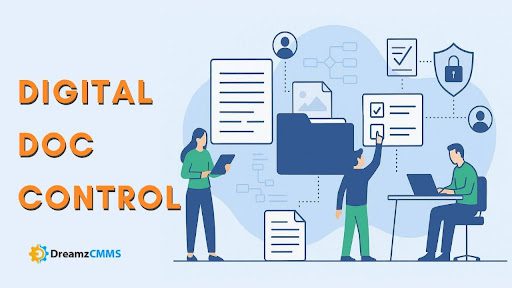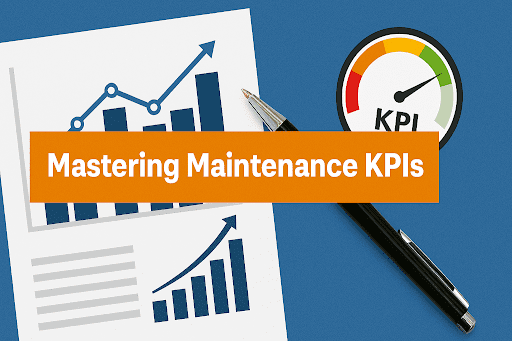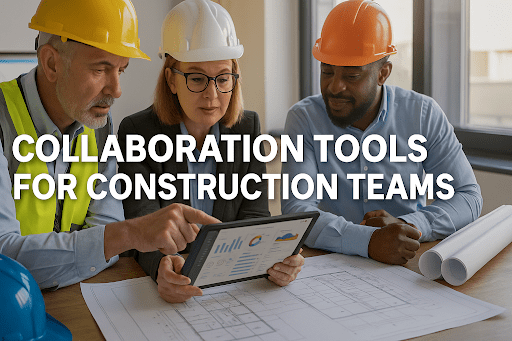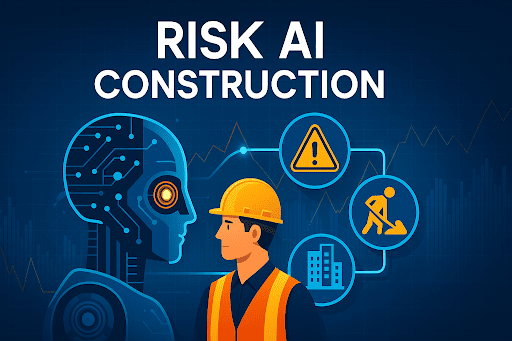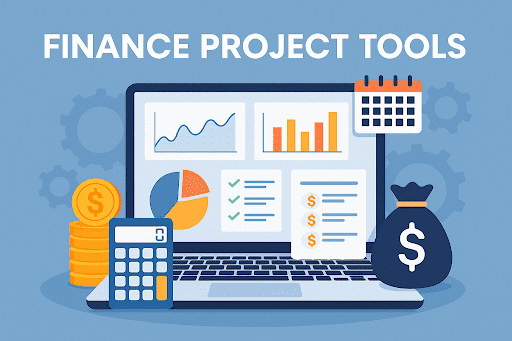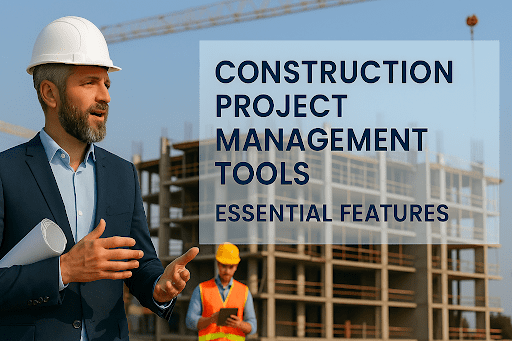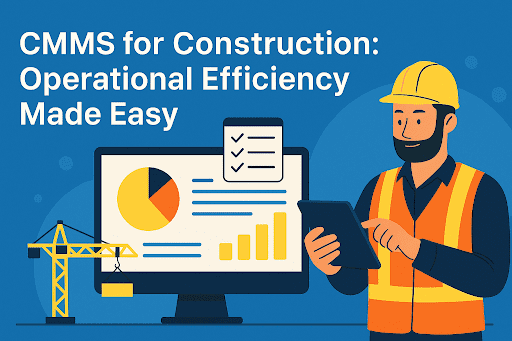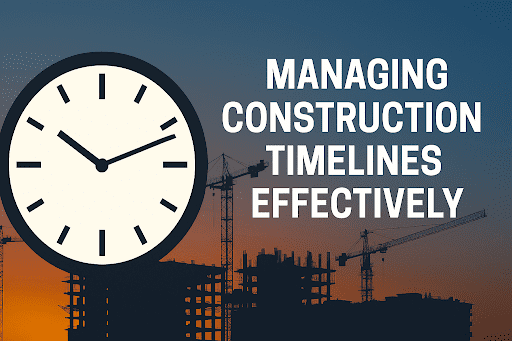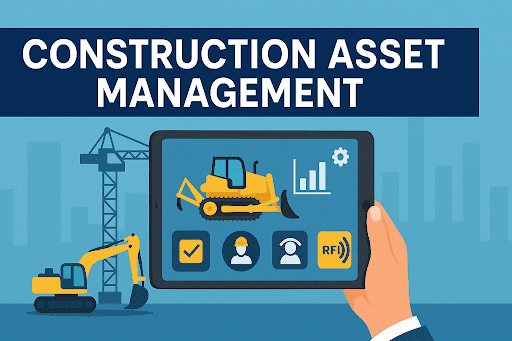 BACK TO Blog
BACK TO Blog
Asset Rental Management
Construction
Introduction Construction remains among the deadliest industries worldwide despite its fast-paced development. The job involves working at heights and operating heavy equipment as standard risks. The development of construction safety technology brings forward new methods to protect workers who work at construction sites. Companies use construction site safety technology with
- June 17, 2025
- DreamzCMMS Team
- 9 minutes read
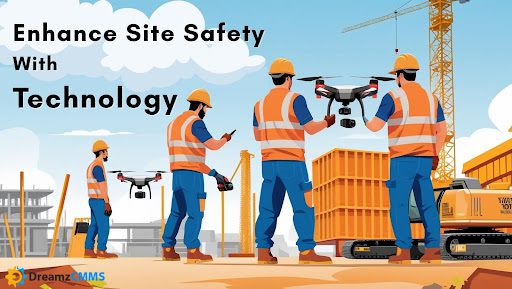
- June 17, 2025
- DreamzCMMS Team
- 9 minutes read
Introduction
Construction remains among the deadliest industries worldwide despite its fast-paced development. The job involves working at heights and operating heavy equipment as standard risks. The development of construction safety technology brings forward new methods to protect workers who work at construction sites.
Companies use construction site safety technology with smart wearables and AI analytics and IoT sensors and cloud-based safety tools to establish safer work environments while enhancing their compliance results. These technologies transform safety strategies and reduce construction site incidents while changing their approaches.
Optimize Equipment Safety with Smart Maintenance Tools
The automated scheduling system combined with real-time tracking enables you to maintain your construction equipment in top condition. The modern job site benefits from predictive asset health monitoring which reduces safety risks and decreases downtime.
Explore Asset Maintenance Management Software
Why Construction Needs Advanced Safety Solutions
Traditional safety methods that include manual inspections along with periodic training and checklists operate as reactive systems which have limited reach. The increasing complexity of construction sites makes these traditional risk detection methods inadequate for identifying present dangers and anticipating upcoming threats.
Digital safety tools for construction stand out by providing advanced solutions. Companies obtain the ability to shift from responding after incidents to anticipating and preventing them. The combination of real-time data and cloud technologies and automation systems elevates safety protocols while offering smarter decision-making tools to the industry.
Core Components of Modern Construction Safety Tech
1. Wearable Safety Devices in Construction
The most important development in connected worker safety systems has emerged from wearable technology. These include:
- Smart Helmets are equipped with sensors to detect falls, fatigue, or impact.
- The system tracks biometric data through Smart Vests and Bands which measure heart rate and stress levels and body temperature.
- GPS Trackers and Proximity Alerts help the system to prevent workers from accessing dangerous areas.
These smart PPE examples for workers allow ongoing safety monitoring of their condition. The system immediately sends safety alerts to job site supervisors through real-time notifications in emergency situations.
2. IoT for Construction Safety
Internet of Things (IoT) devices operate extensively in construction job sites to obtain vital information which they transmit to stakeholders.
- Environmental Sensors help in detecting dust, gas leaks, and temperature spikes.
- Noise and Vibration Sensors send alerts whenever the thresholds are exceeded.
- Machinery Health Monitors help in reducing the risk of mechanical failure that could lead to injuries.
Construction safety benefits from IoT technologies that provide continuous site condition awareness and protect workers from dangerous environmental situations.
Related Read: Learn how tech boosts teamwork in the construction sector with
Collaboration Tools for Construction Teams
3. AI-Powered Safety Monitoring
Construction safety reaches advanced levels through the implementation of artificial intelligence.
- The system uses image recognition to detect PPE non-compliance by identifying workers who do not wear required protective equipment such as gloves or helmets.
- The system uses behavioral analysis to detect unsafe movements and postures that could result in accidents.
- The system uses predictive analytics to analyze job site trends for identifying potential hazards and suggesting safety measures.
The deployment of AI-powered safety monitoring systems enables faster responses while dramatically reducing workplace accidents.
Looking to integrate AI monitoring with daily field operations?
Check out Field Service Management Software for end-to-end site control.
4. Cloud-Based Safety Reporting and Management
The foundation of contemporary construction safety management software consists of cloud systems. They provide centralized access to:
- Incident reports
- Safety audits
- Inspection checklists
- Compliance documents
The implementation of cloud-based safety reporting enables secure data storage with remote accessibility and real-time updates which facilitates better stakeholder information sharing.
Explore More: Discover how digital document workflows improve safety and compliance
Document Management in Construction Projects
5. Mobile Safety Inspection Tools
Smartphones and tablets can now run mobile apps designed for:
- On-the-go hazard identification
- Conducting digital inspections
- Recording site observations
- Reporting near misses
The implementation of mobile safety inspection tools enables faster communication and removes the time-consuming process of paper-based systems.
6. Construction Hazard Detection Systems
Advanced detection systems employ radar, laser scanners together with thermal cameras to achieve their objectives.
- Identify structural shifts or load stress
- Detect proximity to heavy machinery
- Flag unauthorized access or movement
These construction hazard detection systems provide essential protection against unexpected site hazards to workers.
7. Digital Toolbox Talks and Training Modules
Construction sites now conduct daily safety briefings through tablet devices and mobile phones which display interactive visual content. Digital toolbox talks include:
- All team members receive uniform messages.
- The system enables users to store information which serves as evidence during compliance audits.
- Safety education provided through these tools is specifically designed for individual roles and work environments.
The digital safety tools strengthen worker understanding while building a safety-focused culture throughout the entire project.
Safety Compliance Technology for Construction Sites
Safety compliance technology for construction simplifies the process of maintaining OSHA and other regulatory requirements. Features include:
- Auto-generated reports
- Worker training verification
- Real-time documentation of incidents
- Compliance scoring dashboards
The systems minimize administrative costs while providing efficient legal compliance.
Benefits of Adopting Construction Safety Tech
Real-Time Incident Prevention
Construction safety technology revolutionizes operations through its instant ability to identify and resolve potential hazards. The site environment and worker behavior receive constant monitoring through wearable devices together with IoT sensors as well as AI-powered surveillance systems. Real-time safety alerts notify both workers and site supervisors whenever a risk appears including dangerous machinery proximity and toxic gas exposure or worker fatigue signs. Teams can stop accidents before they start through this immediate response ability which reduces downtime and protects human life while minimizing delays.
Reduced Legal and Insurance Costs
The occurrence of safety incidents leads to serious financial losses. Project budgets face strain because of medical claims and regulatory fines as well as legal disputes that also lead to higher insurance premiums which harm reputations. Digital safety tools for construction help organizations decrease their incident rates which results in reduced insurance claims and lower legal responsibilities. The implementation of cloud-based safety reporting alongside construction site incident tracking enables organizations to maintain detailed documentation of all safety activities and inspections and corrective actions. The digital documentation functions as a protective evidence base during compliance audits and legal investigations which creates an extra sense of security.
Workforce Engagement and Satisfaction
A workplace safety culture directly supports productivity. Workers develop trust and better morale because their employer dedicates resources to smart PPE and AI-powered safety monitoring and connected worker safety systems. Employee feelings of value create higher job satisfaction that leads workers to focus better on their main responsibilities. Digital safety systems automate various manual safety inspections which enables workers to focus on their essential tasks thus decreasing their physical and mental workload. The investment in well-being through time leads to better workforce retention along with reduced absenteeism and higher employee engagement.
Increased Project Uptime
Construction site incidents stop all ongoing operations because of either worker injuries or investigations or equipment breakdowns. Small accidents result in major delays to projects which then cause deadline overruns and increased expenses. The implementation of construction safety technology enables risk identification and resolution before they grow into major problems thus sustaining operational continuity and schedule reliability. IoT sensors track structural health as well as machine performance through AI algorithms that predict hazard areas based on weather patterns and worker activities and workload conditions. Project completion becomes more reliable and resource management becomes more efficient through this approach which leads to smooth workflows.
Also Read: Stay on track with risk-aware scheduling
Managing Construction Timelines Effectively
Case Study: Smart PPE Implementation at a Large Construction Project Through a Case Study
A top construction organization launched wearable safety devices throughout their New York high-rise construction sites. The workers received smart helmets together with biometric sensor-equipped vests. During this twelve-month period the organization recorded:
- 35% drop in fatigue-related incidents
- 60% improvement in emergency response times
- 100% compliance rate in PPE use, monitored by AI
The company integrated wearable device data with its construction safety management software for easy reporting and analysis.
Construction site safety depends on Enterprise System integration with Safety Technology implementations.
Integrating Safety Tech with Enterprise Construction Systems
The following system components are required for safety data to achieve maximum power:
- Construction Project Management Software: For resource tracking, job site tasks, and hazard mitigation planning.
- Facility Management Software: To manage infrastructure inspections and safety maintenance schedules.
- Asset Rental Management Software: To ensure safe and timely usage of critical rental machinery and equipment.
Construction sites use this integration to monitor incidents and automate safety procedures which reduces operator mistakes.
Challenges and Overcoming Adoption Barriers
Budget Constraints
The first expenses for hardware, training and software implementation require significant funding. The cost of prevention for injuries alongside productivity benefits will offset the initial expenditure over time.
Worker Resistance
Workers will accept connected worker safety systems once they understand these technologies serve to protect them instead of acting as monitoring tools.
Technical Complexity
IT support exists within the organization for all companies. The transition becomes easier when organizations select straightforward systems and team up with technology partners.
Final Thoughts
The digital shield that modern job sites require for safety operations has emerged as construction safety technology in an industry where safety cannot be secondary. The increasing complexity of construction work requires new safety measures because traditional methods no longer protect workers effectively while maintaining regulatory standards.
The construction industry benefits from predictive safety monitoring through AI systems and smart personal protective equipment that track vital signs and movements to identify risks. The implemented innovations serve two purposes: they prevent accidents while building an active safety system which promotes both operational excellence and corporate protection.
The system provides automated reporting capabilities and simplified compliance management functions while delivering real-time data insights to stakeholders who maintain employee confidence about safety priorities.
Our safety strategies need to adapt because site hazards become more unpredictable because of project schedules, complicated designs and environmental elements. Construction companies who implement data-based safety systems with technological support today will dominate future industry standards through performance excellence and workforce trust and cost reduction and personnel protection.
The time has come for construction leaders to transition from basic safety policies to smart predictive solutions that guarantee workers return home safely each day.
Take the Next Step Toward Safer Construction Sites
Leverage cutting-edge technology to build a safer, smarter, and more efficient work environment. From compliance tracking to real-time hazard alerts, DreamzCMMS empowers your team with powerful safety tools.
Ready for More?
Talk to one of our CMMS experts and see how DreamzCMMS can simplify your maintenance operations.
Book a free consultation